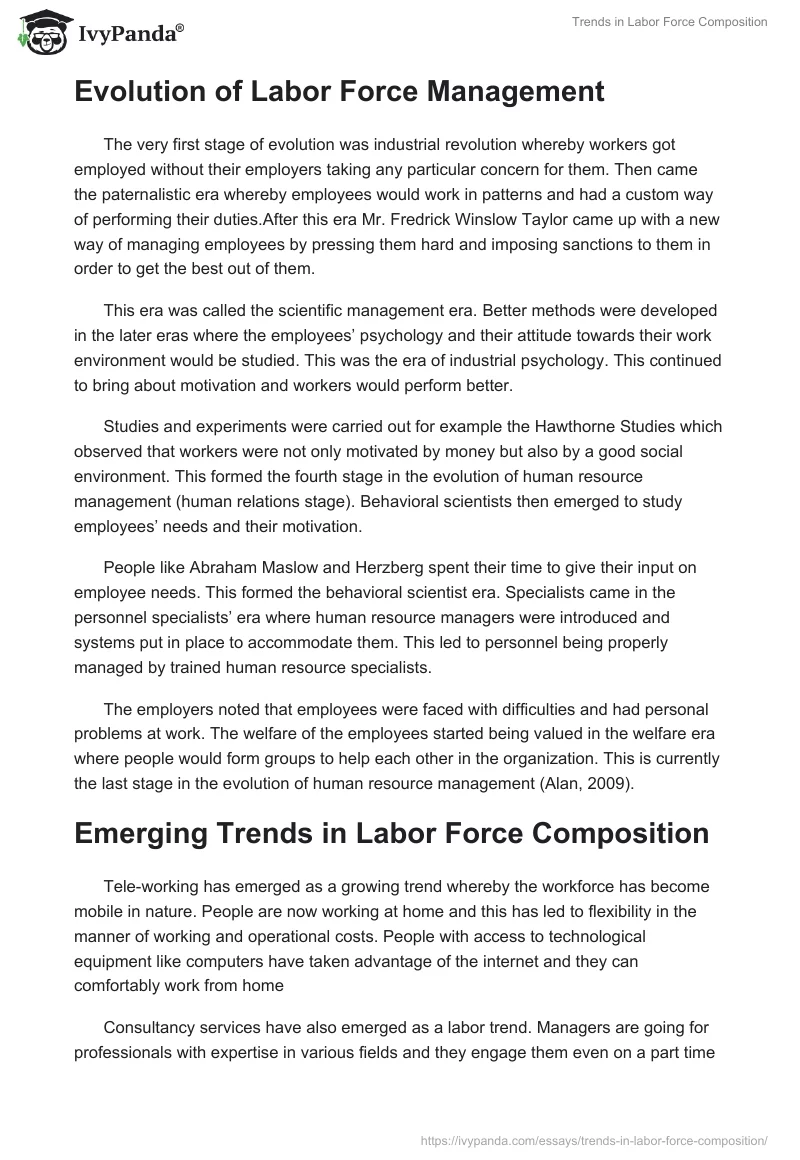Introduction
Human Resource Management is a practice that has been in place since time in memorial. Amongst the factors of production, labor is listed as the most important factor and is highly capital intensive. Labor is the only resource in any business organization that has a feeling and therefore needs to be well managed without ignoring any single aspect of it.
In any organization, the labor force requires constant training and motivation through pay hikes and bonuses. At the same time people need protection and proper working conditions. In order to achieve this, it is paramount that there is a management process that is sound and well organized to specifically handle employee related issues. Human Resource Management has evolved over the years.
It has gone through radical changes due to dynamism in social, cultural, political as well as technological advancement of human beings (Armstrong, 2009). These changes have led to emergence of several trends in labor composition. This essay focuses on the trends in labor composition and evaluates how such trends affect the management of human resources.
Human Resource Management vis-à-vis Personnel Management
There has been confusion about the above two practices whereby people have thought that personnel management and human resources management are the same thing. In contrast, human resource management has to do with managing people from a broader perspective and focuses on planning and control. Personnel management on the other hand focuses on the work force, issues affecting the employees and the work environment (Armstrong, 2009).
Evolution of Labor Force Management
The very first stage of evolution was industrial revolution whereby workers got employed without their employers taking any particular concern for them. Then came the paternalistic era whereby employees would work in patterns and had a custom way of performing their duties.After this era Mr. Fredrick Winslow Taylor came up with a new way of managing employees by pressing them hard and imposing sanctions to them in order to get the best out of them.
This era was called the scientific management era. Better methods were developed in the later eras where the employees’ psychology and their attitude towards their work environment would be studied. This was the era of industrial psychology. This continued to bring about motivation and workers would perform better.
Studies and experiments were carried out for example the Hawthorne Studies which observed that workers were not only motivated by money but also by a good social environment. This formed the fourth stage in the evolution of human resource management (human relations stage). Behavioral scientists then emerged to study employees’ needs and their motivation.
People like Abraham Maslow and Herzberg spent their time to give their input on employee needs. This formed the behavioral scientist era. Specialists came in the personnel specialists’ era where human resource managers were introduced and systems put in place to accommodate them. This led to personnel being properly managed by trained human resource specialists.
The employers noted that employees were faced with difficulties and had personal problems at work. The welfare of the employees started being valued in the welfare era where people would form groups to help each other in the organization. This is currently the last stage in the evolution of human resource management (Alan, 2009).
Emerging Trends in Labor Force Composition
Tele-working has emerged as a growing trend whereby the workforce has become mobile in nature. People are now working at home and this has led to flexibility in the manner of working and operational costs. People with access to technological equipment like computers have taken advantage of the internet and they can comfortably work from home
Consultancy services have also emerged as a labor trend. Managers are going for professionals with expertise in various fields and they engage them even on a part time basis. This has increased professionalism, integrity and work quality staff (Hal and Diana, 2005).
There has been a dynamic change in the manner in which human resource managers recruit staff. Organizations are now outsourcing their staff and this has led to a situation whereby only qualified and reputable candidates are preferred in the labor market. This has lead to staff downsizing in many organizations as most services may be outsourced to other companies.
Use of technology (automation) is another trend that is currently used. Human resource managers have gone ahead to ensure that they embrace automated systems as opposed to manual systems. Automation has led to laying off of many employees since machines are cost effective and more accurate than human beings hence preferred by organizations (Clogg C, Eliason Scott, & Leicht K, 2001).
Conclusion
In summary, there is dynamism in labor force trends and composition. Composition of laborers will vary depending the kind or labor required by an employer. Human resource managers should critically study and understand the kind of labor trends and composition before recruiting employees. In doing so, organizations will have happy and very productive employees. Newer labor trends are expected to emerge as technological advances and social dynamics continue to affect the global work force.
Appendix
Individual Contribution Table
References
Alan, P. (2009). Principles of Human Resource Management, 4th edition. John Wiley & Sons Publication.
Armstrong, M. (2012). Hand Book on Human Management Practice: London.12th Edition. Kogan Page Publishers.
Clogg C, Eliason Scott, & Leicht K, (2001) Analyzing the Labor Force: Concepts, Measures, and Trends. Springer Publication.
Hal G, and Dianna L. (2005). The Brave New World of eHR: Human Resources in the Digital Age. John Wiley & Sons Publication.


